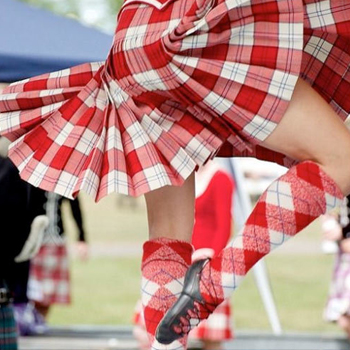The origins of Scottish Highland dancing like most of our Scottish traditions are swathed in the mists of time. Our proud history and traditions were orally told and passed through the generations. It is said that the old kings and clan chiefs would hold Highland games as a means to select the best men at arms to be at their disposal. The Highland dances demonstrated their strength, stamina and agility.
The first documented evidence we see is at the second marriage of Alexander III to his French bride Yolande de Dreux at Jedburgh in 1285 where an intricate war dance was performed to the sound of the highland bagpipes.
At the reception in honour of Anne of Denmark 1589 there was a sword dance and a number of ‘Hieland Danses’ performed before King James VI.
In 1633 a sword dance for Charles I was performed on a raft in the middle of the river Tay.
There is another story which states that some Scottish mercenaries in the court of the Swedish King John III 1573, performed a sword dance at a banquet with the intent of assassinating the King. They had planned to use the swords in the dance as the weapons. Luckily for the King the correct signal was never given so the plot was never carried out.
It is also been thought that many of the steps in the dances come from the French court possibly brought over by Mary, Queen of Scots or Scottish gentlemen present.
After the Proscription of 1746 the wearing of tartan, carrying of arms and anything remotely involved with the highland culture was banned. Highland dancing was yet another thing that could have been lost. When the ban was lifted after 36 years later there was little encouragement for people to take up any of the the old traditions. It was thanks to Sir Walter Scott that tartan was revived. But it wasn’t until Queen Victoria and her passion for Balmoral and all things Scottish that Highland dancing came back. This revival saw the beginnings of the modern Highland games that we see today only this time there was a lot more emphasis on Highland dancing. Unfortunately, to make judging easier at the games through the years the selection of dances that were available was whittled down gradually leaving just the 4 dances that we see today. Due to this I’m sure we have probably lost quite a few traditional dances.

Throughout history it was only men that performed these dances and it was only during the late 19th century that women started to dance them. A woman named Lorna Mitchell came along and decided to enter one of the competitions and as there was no rules forbidding it, that the judges could find, she was allowed to perform. Since then the number of women have increased and slowly through the years it has become mainly females dancing in fact today it is 95% women.

The dances themselves have their own wee histories:
The Sword dance – Gille Chluim (servant of Calum)
One of the tales say that King Malcolm III Canmore during the battle of Dunsinane on the 24th July 1054 killed a fellow chieftain. He celebrated his victory by dancing over his own bloody claymore crossed with that of his enemy.
Another legend says that a soldier would dance over the crossed swords prior to battle and should his feet touch the blade it was considered a bad omen.
The simplest and probably the correct version is that the dance was simply an exercise to develop and hone the nimble footwork required during swordplay. Something an early King or chieftain might have been looking for at the original Highland games.
The Seann Truihas (Gaelic for old trousers)
This dance was supposed to show the highlanders disgust of having to wear trousers after the proscription of 1746.
Another version of this is that a Highlander was showing of his new trews to the English king.
The Highland Fling
It is said that this was a warrior’s dance of triumph after a battle. The targe (shield) was thrown down and danced around.
Another says it comes from a young boy imitating the movements of a stag on the hillside, the curved arms symbolising the antlers.
As with the sword dance the simplest and probably the correct version is that the dance was simply an exercise to develop and hone the nimble footwork required during swordplay. Only this time there was a targe with a large pike (could be 6” in length) coming out of the middle.
The Reel of Tulloch – Ruidhle Thulaichean
It is said that one very cold morning while waiting outside their church, waiting for the minister to let them in, the parishioners trying to keep warm started to stamp their feet and clap there hands. Another parishioner started to whistle an old highland tune and the dance was born.
Or a more gruesome tale was; It came from a game of football played by the men of Tulloch but instead of a ball they used the head of an enemy.

I am so proud to learn more about my family ancestry and want to thank you for such a great website.
Very interesting information!!
Nikki, a reminder that The 1746 Act of Proscription forbade the wearing of male civilian highland clothes, it did not ban the wearing of tartan.
And the revival, whilst later orchestrated by Sir Walter Scott, was in fact started some 40 years earlier by the Highland Society of London.
I want to learn Scottish highland dancec
Very inteteresting, I love your history lessons